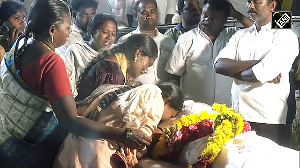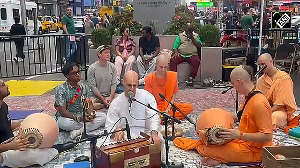Some unidentified people shot Nayeem at point-blank range and fled. Like many previous killings in AMU, it is not known who killed Nayeem and why.
Students close to Nayeem say he was not involved in any controversy, did not have any love affair; there was no known rivalry in his family in the Baghpat district of Uttar Pradesh. The boy was gentle, religious, and had a small friend circle of like-minded students.
Thus, in many ways, this murder resembles a series of murders in the recent past in AMU -- a residential university which is home to 25,000 students in the north Indian town of Aligarh, about 125 km from the national capital New Delhi.
In April, two undergraduate students were killed in separate incidents. The murders were then linked to the ongoing process of empanelment of the new vice-chancellor as the then vice-chancellor Naseem Ahmad had completed his five-year term.
Nayeem's murder was followed by mass violence on the campus on Monday. Angry students burnt the vice-chancellor's home, the proctor's office and other university property.
The students' anger and frustration mounted because before Nayeem's murder, a Class IX girl was allegedly raped by some non-teaching employees of the girls' hostel on September 8. Despite protests, no action was taken against the alleged rapists.
The administration allegedly tried to cover up the incident, but the girl students broke out of the hostel on September 12 and staged a demonstration before the VC's office. Only wide media coverage persuaded the vice-chancellor to institute an inquiry, that too headed by a male, which is in violation of Supreme Court's directives.
Why the violence?
The student upsurge in AMU often starts with violence and ends with the sine die closure of the university. The students say the AMU administration either tries to deny the existence of grievances or refuses to redress them. This frustrates the students.
The killing of Iqbal Barula, a teacher of theology, in broad daylight in the early 1990s, the murder of history teachers Rajiv Sharma and Dr I G Khan, the murder of a student named Nadeem in 1996, and the two murders in April this year, all produced no result, no action, and no justice.
This could be the reason for the killers getting encouraged and feeling safe. The central concern of the students is: Why do criminals go scot-free?
Recent history
In May, then vice-chancellor Naseem Ahmad was about to complete his tenure. Therefore, in April, he had to complete the process of empanelling his successor. But he reportedly came under tremendous pressure from different lobbies among the AMU employees, who were pushing for their own candidates for VC. Ahmad could not withstand these pressures and quit AMU in the first week of April.
After he left, two murders took place (in the first and last week of April). There seemed to be no reason for the murders of seemingly innocent students.
There were murmurs inside the university that the murders were intended to create turmoil on the campus so that opinion could be mobilised to empanel a civil servant (not an academic) as the next VC.
However, in May, P K Abdul Azis, an academic and then vice-chancellor of the Cochin University of Science and Technology, was appointed VC. This move was resented by many AMU staffers. Outlook magazine published a report questioning Azis's academic credentials, which further affected his acceptability.
The flashpoints
1. Azis, soon after taking charge, went on frequent leave, even when the admissions to graduation and post graduation courses were on in the first fortnight of August.
2. His decision to drastically reduce the intake of PhD candidates agitated senior students since they stood to lose scholarship/stipend of Rs 5,000 a month, recently announced by the Union human resources ministry. Not only this, he disallowed PhD candidates from submitting their theses if they had exceeded five years of registration. He did it without referring the matter to the academic council.
3. The VC's decision to remove all teachers having additional administrative responsibilities like officers on special duty, manager of schools and other such posts, added to the discontentment.
4. The VC's decision to award tenders of building constructions to the Central Public Works Department, rather than local contractors, supervised by the university's building department, has added to the woes of insiders who used to make money out of this business.
There is apprehension that the recent crisis could have been created in response to the 1997 Mathew Commission report that was made public two months ago. The Commission exposed mass-scale violation in appointment of teachers in the departments of geography, history and political science. The recent crisis has been successful in diverting public attention from the report.
The series of crises and the closure of the university sine die in the last decade indicates a trend. It revolves around the vice-chancellor's office. Different teachers and students lobbies are always active on the campus trying to get close to the vice-chancellor. This is how they get access to AMU's vast resources; the university has an annual budget of Rs 245 crores.
Proposed solution of the crisis
A high power inquiry committee consisting of judges and bureaucrats should be instituted and must probe the incidents between April and September comprehensively. Previous vice-chancellor Naseem Ahmad should be asked to depose before the committee to expose the individuals and situations that forced him to quit AMU suddenly.
The correspondent, who did not want to be identified for this article, teaches at AMU.





